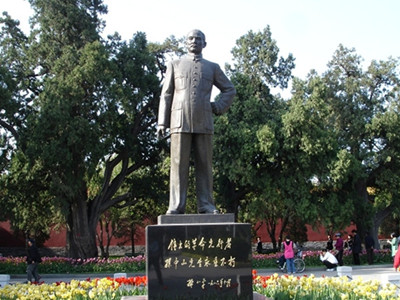Zhongshan Park [ Related Itinerary ]
 Beijing Zhongshan Park is located in the south of the Forbidden City and west of the Tiananmen Square, where originally was a site of imperial sacrifices.
Beijing Zhongshan Park is located in the south of the Forbidden City and west of the Tiananmen Square, where originally was a site of imperial sacrifices.The Zhoangshan Park is a memorable classical temple garden, covering an area of 230,000 square meters. It was initially built as the Xingguo Temple of Liao and Jin Dynasty, and renamed Wanshou Xingguo Temple in Yuan Dynasty. In the year of 1421, when the Emperor Zhudi of Ming Dynasty moved the capital city to Beijing, this temple became a sacrifice place and renamed the Altar of Land and Grain (Shejitan). This temple was the place used by the Ming and Qing emperors sacrifice to gods of earth and the grain. In 1914, it was changed to central park and opened to the public. In honor of Dr. Sun Yat-sen, China's first revolutionary leader bringing about the first republic in 1911, this site was named as Zhongshan Park in1928.
Covering an area of 218,000 square meters, Zhongshan Park is a beautiful garden with a rich and influential culture, which reminds people of the understanding of the history of china. The main structure in the park is the ancient Altar of Land and Grain (Shejitan). Shejitan is a three-level square terrace built of white marble, which is the symbol of imperial power and good harvests. The upper platform is paved by soil in five colors, so it is also called the Five-Color Soil Altar. It is the sacrifice place where emperors pray for good harvests. Besides the main Shejitan, Zhongshan Hall and Forbidden City Concert Hall in the park are also deserve a visit. Zhongshan Hall was originally named the Worship Hall. When met the bad weather, the emperors would come here to worship. It is believed to be the most intact building of Ming Dynasty. And why it got the name of Zhongshan Hall? This is because the coffin of Dr. Sun Yat-sen was once placed there. The Forbidden City Concert Hall built in 1942 lies to the southeast of Zhongshan Hall. Covering an area of over 4,000 square meters, it is a modern multi-functional theater combines both Chinese and Western architecture styles.
Also the beautiful flowers and ancient cypresses welcome you all the year round. It is really a nice place for leisure in the city center of Beijing.
Related Itinerary